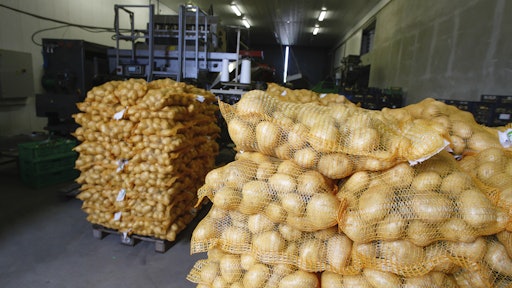
The Food Safety Modernization Act (FSMA) will change some aspects of how the food and beverage (f&b) supply chain operates. That much can be assumed, based on the Food and Drug Administration (FDA) statements about the biggest overhaul to food safety law in 70 years.
Among the most significant changes under FSMA is the shift towards preventing problems rather than reacting to them after they occur. The FSMA gives the FDA new enforcement authority to achieve higher rates of compliance with prevention- and risk-based food safety standards and to better respond to and contain problems when they occur. The law also gives the FDA new tools to hold imported foods to the same standards as domestic foods and directs the FDA to build an integrated national food safety system in partnership with state and local authorities.
The FSMA contains seven separate sets of standards: produce safety, preventive controls for human food, preventive controls for animal food, foreign supplier verification for imports, accreditation for third party auditors to conduct safety audits, sanitary transportation, and strategies to prevent intentional adulteration.
After a review of public comments in September 2014, FDA released “supplemental notices of proposed rulemaking” that propose modifications to the original proposed rules. FDA accepted comments on the issues raised in the supplemental notices until Dec. 15, 2014. Under a court order, FDA is required to issue the final rules in 2015.
The FDA has proposed the effective date to be 60 days after the final rule is published. Recognizing that small and very small businesses may need more time to comply with the requirements, the compliance dates are adjusted accordingly. Compliance dates are:
• A business that has less than $10 million in total annual sales of food would have to comply within three years after the publication of the final rule.
• A business employing fewer than 500 persons would have to comply two years after the publication of the final rule.
• A business that does not fall under the two conditions listed above and does not qualify for exemptions would have to comply one year after the publication of the final rule.
Some aspects will take effect quickly, such as mandatory recall authority, while others will take longer because the FDA is working on technical guidance documents to provide advice on how to implement food safety preventive controls.
Industry stakeholders weigh in
Industry stakeholders have worked with FDA on all of these areas as the agency has undertaken the process of establishing rules for safe practices. But as this article will explain, the FDA is far from finished with several aspects, particularly those that govern f&b transportation.
Supply chain decision makers support the goal of FSMA and give the FDA high marks for working with industry in the requirements. Many who took the time to comment commended the FDA for using a risk-based approach in the rule making.
In reviewing more than 100 comments submitted to the FDA about the proposed rules, Food Logistics observed many stakeholders are concerned about how the law assesses who is responsible for meeting safety standards while product is in transport. Stakeholders also want clarification over what types of shipments are covered. A lot of concern has also been raised about temperature control requirements for perishable food in transit.
From reviewing stakeholders’ comments, it is clear that f&b supply chain managers are concerned about specific wording of many of the rules. Comments sought clarification of terms such as “shipper” and “farmer.”
Given the number of comments and the amount of the detail provided to the agency, it is clear that the supply chain community recognizes the far reaching impact the law will have on their operations.
Major concern: sanitary transport
While the supply chain community commented on all aspects of the FSMA law, the sanitary transport rules drew the most concern. The FDA claims the proposed sanitary transport rule builds on current food transportation best practices concerning cleaning, inspection, maintaining, loading and unloading, and operating vehicles and transportation equipment.
Industry stakeholders raised questions about temperature monitoring, how the law defines a shipper, what the extent of the shipper’s responsibility for subsequent shipments, responsibility for short distances, and the overlap in enforcement between FDA and other agencies.
The requirements for continuous temperature monitoring of shipments drew the most comments. Some expressed concern that the proposed wording of the rule could give some enforcement officials the idea that temperature recording devices are needed and that at all items, particularly fresh produce, need to be refrigerated.
The American Trucking Associations (ATA) claimed temperature monitoring requirements are unneeded and the existing regulations are doing the job. “ATA believes ‘the goal’ is already being reached,” the ATA’s letter states.
Several stakeholders felt the agency was basing temperature monitoring requirements on quality control standards, not safety standards.
“The agency should be cognizant of the distinction between temperature control requirements for food safety and temperature control requirements for food quality control and avoid any language which would tend to conflate the two often quite disparate requirements,” wrote England Logistics. “If safety level requirements are used interchangeably with quality level requirements, a flood of unnecessary cargo claims and mountains of wasted food will result.”
Lance Jungeneyer, president of Fresh Produce Association of America (FPAA), wrote that fresh produce is transported under temperature control to preserve quality. “Additionally, no foodborne illness investigations linked to fresh produce have identified lack of temperature control during transportation as a likely contributor to causing the incident. Foods should not contain human pathogens when placed into commerce, and FDA does not designate allowable limits for human pathogens. Therefore, time and temperature controls for safety seems overly protective and a redundant preventive control.”
“Minor breaks in the cold chain do not definitively mean that a food is unsafe for human or animal consumption,” wrote Jungeneyer.
The Grocery Manufacturers Association (GMA) voiced a similar view. “GMA has concerns that the proposed rule could be understood to suggest a requirement for continuous monitoring of temperature regardless of the food safety need, which could add considerable cost without a corresponding food safety benefit,” Roger Lowe, executive vice president of strategic communications, told Food Logistics. “We believe that FDA’s sanitary transportation requirements should align with leading industry practices, which is FDA’s stated intent. GMA believes that FDA should revise the temperature monitoring practices to be in alignment with current and effective industry practices that ensure food safety.”
Carriers can – and often do – engage in continuous temperature monitoring, but there are some parts of the industry where continuous temperature monitoring is not the norm because there are other methods to ensure safe transportation of food, Lowe says. “As one example, sometimes the temperature of the product and/or cargo area is checked upon departure and arrival; this can be sufficient to demonstrate that the food remained safe,” he says.
“GMA contends that, instead, FDA should further tailor the regulation so that it affects only the key areas of public health concern—safety of shipments subject to temperature-control to prevent adulteration, bulk shipment where the food comes into direct contact with the vehicle, and food not fully enclosed by a container.” Says Lowe: “This is preferable to some aspects of the proposed approach, like the suggested need for continuous temperature monitoring that is routinely communicated to the shipper by the carrier. That would add considerable cost in this area – but there is no demonstrated food safety problem that needs to be rectified.”
“We do not believe that it is necessary for the FDA to mandate continuous monitoring of temperature during transport as we believe that existing procedures, documentation of temperatures on loading and receipt with inspection of the condition of products upon receipt, are sufficient for most of our products,” Edie Burge, Nestle USA’s corporate communications manager, told Food Logistics.
A carrier must already demonstrate to the shipper that the temperature conditions during transportation are consistent with those that the shipper specified, says Donna Garren, Ph.D., senior vice president of regulatory and technical affairs at the American Frozen Food Institute (AFFI). Such demonstration “may be accomplished by any appropriate means agreeable to the carrier and shipper such as the carrier presenting printouts of a time/temperature recording device or a log of temperature measurements taken at various times during the shipment,” says Garren, “We are concerned that this proposed requirement does not align with current industry practices that are established as adequate for food safety.”
AFFI maintains that carriers should only be required to demonstrate compliance with the shipper’s temperature conditions on an exception basis—if there is a question about the condition of the food—not on a routine basis. Moreover, FDA’s requirements should make clear that a deviation from the shipper’s temperature requirement does not necessarily make the food adulterated.
Mandatory temperature devices?
The International Foodservice Distributors Association (IFDA) urged FDA to make clear that the use of temperature recording devices is not mandatory, and that the requirements of the rule may be satisfied in a variety of ways. “If this flexibility is not made more explicit, IFDA is concerned that inspectors may insist on the use of such devices, or that carriers and shippers may feel that the only way to satisfy the rule and agency expectations is by the use of such devices,” wrote Jonathan Eisen, IFDA senior vice president of government relations.
One industry expert, Jeff Leshuk, vice president of strategic marketing and business development at Sensitech Inc., warns that the rule as written would make both the shipper and the carrier responsible for temperature control. “On a more technical level specifically related to temperature, there are many factors that influence good temperature management,” Leshuk told Food Logistics. “All of the parties involved have some role in ensuring proper practices are followed, so again responsibilities need to be allocated in a manner that is logical. The industry has been doing this well for many years.” He said the proposed rule would create a disconnect from the practices successfully employed today. “Portable temperature monitoring devices have been used successfully for many years with placement of the devices handled by the shippers upon loading, and recovered, downloaded and acted upon by the receiver,” he says.
To address this disconnect, Leshuk says the rule be revised to allow for flexibility for suppliers, carriers and receivers to allocate the various responsibilities for the safe transportation of food among themselves in the manner that is best suited to their particular situation.
Several groups, such as the National Restaurant Association, opposed the requirement that cold storage compartment in vehicles that can support the growth of microorganisms have temperature recording devices. NRA felt trailer gauge monitors that record temperatures twice per route day should be acceptable.
The United Fresh Produce Association said the rule should allow for shippers’ procedures to include temperature measuring/recording devices instead of requiring carriers to have such devices installed. “In other situations, produce companies may ship product in small cooler boxes with icepacks, relying on such for temperature control, not the carrier; the rule should allow the shipper to employ such options,” UFPA wrote.
The American Meat Institute (AMI) and the North American Meat Association (NAMA) firmly opposed the requirement that certain transportation equipment “must be equipped with an indicating thermometer, temperature-measuring device or temperature-recording device so installed as to show the temperature accurately within the compartment,” wrote Barry Carpenter, CEO of the NAMA and Mark Dopp, senior vice president of regulatory affairs at AMI.
“Currently, it is not a routine practice for carriers to demonstrate to shippers (or receivers) that the shipment met the shipper’s temperature requirements. Rather, such records generally are only provided if there is an indication of a problem (i.e., signs of temperature abuse) upon receipt of the load,” they wrote.
The Juice Products Association (JPA) requested that FDA modify the rule to provide that carriers only are required to engage in continuous temperature monitoring if specified as necessary by the shipper. “Correspondingly, carriers should not be required to demonstrate compliance with the shipper’s temperature requirements unless requested to do so by the shipper or receiver,” noted Patricia Faison, JPA technical director.
The FDA has emphasized its interests in developing rules that are consistent with industry practices to ensure food safety. The temperature control requirements for transporting food remains an area that needs clarification.
Who’s a ‘shipper’?
Another aspect of the sanitary transport rule that raised concern is who is responsible for food safety. The proposed rule puts much responsibility for safe transport on the shipper. Several stakeholders said the FDA must clarify how it defines “shipper.”
Sensitech’s Leshuk notes that under many circumstances, the shipper does not have much control over the transport once it leaves his facility. “As one very simple example, most of the domestically-grown, fresh perishable produce is shipped FOB (free on board), which indicates that the person or organization receiving the order is responsible for freight costs and liability for the product thereby giving the shipper little control,” Leshuk told Food Logistics.
The International Warehouse Logistics Association (IWLA) took issue with the FDA's definition of “shipper” as “a person who initiates a shipment of food by motor vehicle or rail.”
Steve DeHaan, president and CEO of IWLA, gave the example of a warehouse-based 3PL that removes three pallets of packaged frozen shrimp from the warehouse and prepares it to be loaded on to a truck arranged for by the owner of the product. Who in this example is initiating the shipment?
“What if the 3PL calls for the truck at the direction of the product owner? And, what if the 3PL is listed as the shipper on the bill of lading? Under the current definition, we do not think the answer is clear,” DeHaan wrote. A 3PL warehouse could be interpreted as "the initiator," i.e., the shipper, even though the warehouse owner does not have the knowledge or control over the product to assure its safe transportation.
“We think the definition of a "shipper" should be clearly defined as a person with ownership of the food product,” DeHaan wrote.
While the FDA proposes to define a shipper as a person who initiates a shipment, “there are many different parties, however, who could be said to ‘initiate’ a shipment of food,” wrote Carol Freysinger, executive director of The National Pasta Associated (NPA).
On this point, the American Trucking Associations (ATA) noted the regulatory definition of “shipper” should clarify that it does not directly include logistics providers who merely arrange for transportation services on behalf of clients, and who are not necessarily knowledgeable about the products being transported, or the conditions required to protect individual products.
“How can the first shipper know what happens at the next warehouse?” asks Lance Jungeneyer, of the Fresh Produce Association of the Americas. “There’s only so much that a shipper can be responsible for after it leaves his warehouse.”
Shipper responsibilities
Regardless of how a shipper is defined, some stakeholders feel the proposed rule holds the shipper unduly responsible for subsequent additions to their trailers by other shippers.
“It is imperative that the agency adequately address shipments of this type, recognizing that while the first shipper may take every precaution necessary to remain in conformance with the rule, they should not be responsible for subsequent additions to the trailer by other shippers,” Peter Chaires, executive vice president of Florida Citrus Packers told Food Logistics.
Railroads Raise Concerns About Sanitary Transport Rule
The Association of American Railroads and the American Short Line and Regional Railroad Association listed numerous problems with the sanitary transport rule. They claimed the rules are based on fundamental misunderstanding of the functions of the railroad carrier with regard to transportation of commodities, including food. They noted that the railroads have sound practices in place to ensure the safety of the country’s food supply. “The lack of instances of contamination associated with the transportation of food by rail is also indicative that railroad customers are utilizing appropriate practices and procedures,” wrote Keith Borman, counsel for the ASLRRA and Louis Warchot and Sarah Yurasko, counsel for AAR.
The associations said the rule should clarify that “transportation operations” not include the transport of food that is completely enclosed by a container and can be stored in ambient temperature and humidity conditions.
The associations also noted that railroads have no way to segregate to protect food from contamination by raw food or non-food items on the same load. They noted railroads accept loaded railcars, often sealed by the shipper, and haul them as instructed.
The Global Cold Chain Alliance commented that the rule needs to do a better job clarifying the responsibility of 3PLs. “Given the new responsibilities proposed for shippers, there should be additional clarity regarding the role of third party providers and under what circumstances they will and will not be considered shippers for purposes of the rule,” wrote Corey Rosenbusch, president and CEO of GCCA.
Requirements for carriers also raised some concern. The National Council of Farmer Cooperatives (NCFC) noted that the proposed rule would require a carrier to disclose the previous three loads to the shipper, so that the shipper can confirm that the vehicle is sanitary. However, in situations where there is a dedicated truck moving the same commodity or byproduct, this requirement is unnecessary and overly onerous.
NCFC also noted the FDA uses the term "sanitary" within the rule yet fails to adequately define it.
Intra company and short distances
Another area many industry players objected to was the rules for short and intra company shipments.
The Grocery Manufacturers Association (GMA) has requested that FDA modify the rules for shorter distance shipments because they do not need the same level of oversight as transportation that covers longer distances. “Under the proposed rule, all transportation would be regulated in the same manner—regardless of the distance,” the GMA’s Lowe told Food Logistics. “GMA does not believe that the same longer-distance regulations need to apply in situations such as food transported only a few miles between a manufacturer’s production and storage facilities, between a production facility and customer’s facility or in situations where a company’s fleet of trucks run a continuous loop throughout the day between two local facilities.”
The National Pasta Association raised a similar concern. “This approach is not risk-based, as shorter distance shipments may not require the same level of oversight as longer distance transportation,” wrote NPA’s Freysinger. “For example, if a company runs a shuttle service between its manufacturing facility and a warehouse a few miles away, it may not be necessary to have written documentation addressing previous cargo loads or cleaning of the vehicle.”
Walmart wants the FDA to reconsider the rule governing intra company shipments. “Retailers who maintain control over the movement of food once it reaches a company-owned DC or other retailer-controlled intermediate destination should be dealt with separately in any rule and be subject only to good sanitation practices and procedures and adequate training, all of which are current industry standard practices,” wrote Frank Yiannas, vice president of food safety and health. “Retailers’ track record of handling food is exemplary and does not need to be subjected to rules that apply equally to means of transportation that are not under the control of a single entity.” He suggested an exemption for intra-company transportation.
Walmart also took issue with the requirement to isolate or segregate ready-to-eat from raw foods. “If the language of the proposed rule is not clarified, there is the potential for an interpretation requiring the complete isolation of raw foods from ready-to-eat foods during transportation. This interpretation has the potential to significantly impact current industry processes used to ship foods, resulting in reduced food chain efficiency, an increase in the carbon footprint (and food miles) for retailers as additional shipments of product would be required to accommodate these shipping requirements, and increased fuel usage,” Yiannas wrote.
Farm definition
Establishments that fall within the definition of “farm” are exempt from FDA’s food facility registration requirements. Hence, the definition of “farm” drew a lot of stakeholder interest. FDA revised the definition in its supplemental proposed rules.
The Fresh Produce Association of the Americas (FPAA) applauds the clarification of the farm definition. “Just because a packing house is attached, it’s still a farm,” says FPAA’s Jungenmeyer.
The FDA created some confusion when the farm definition in the original preventive controls and produce safety rules differed from the one in the sanitary transport rules.
“When the FDA released the supplemental proposed rules for preventive controls and produce safety, the definition of ‘farm’ was modified from the original proposed rules,” says Tim Slawinski, emerging issues specialist for food and dairy at the Michigan Department of Agriculture and Rural Development (MDARD). “The new definition of ‘farm’ is now much closer to the definition that is in the proposed sanitary transportation rule. Therefore, the MDARD concerns about the consistency of the definition seem to have been addressed with the release of the supplemental rules.”
Chiquita Brands International Inc. requested the FDA further revise the sanitary transportation rule to provide that all transportation activities for raw agricultural commodities from a farm are exempt, regardless of who performs the transportation.
Courtney Parker, Chiquita Brands vice president of salad quality and global food safety, wrote her company hires third-parties to transport RACs from the farm to its cooling facility. Under the proposal, this transportation would not be exempt. But, if a farmer engaged the same third-party to transport the produce, the transportation would be exempt because the farm is performing the transportation by initiating the shipment.
“These distinctions seem arbitrary and could encourage unnecessary restructuring of contracts to fit within the exemption (e.g., purchasers requiring growers to hire the third-parties to transport the produce, rather than hiring the third-parties themselves),” wrote Parker.
“Our proposed approach is more risk-based than the proposed rule, as the safety of produce does not change based on whether or not a farmer performs or contracts the transportation,” Parker wrote.
Company size exemption
One area that drew nearly unanimous concern among stakeholders was the exemption of small shippers.
The proposed rule contains an exemption for any shipper, receiver, or carrier engaged in food transportation operations that does less than $500,000 in total annual sales.
“We do feel that all carriers should be subject to any proposed rule, for several reasons,” says Tyler Hayes, associate general counsel at England Logistics Inc. One reason relates to the reality of the motor carrier market, he says. “The vast majority of the motor carriers authorized by the FMCSA (Federal Motor Carrier Safety Administration) operate six or fewer trucks which would likely result in those carriers being exempt from the sanitary transport rules.”
Hayes further notes the exemption would likely have the effect of tightening capacity in an already tight market.
“This exemption is a major concern, because 90 percent of licensed motor carriers operate six or fewer trucks, and might, therefore, not be subject to these requirements,” Robert Voltmann, president and CEO of the Transportation Intermediaries Association, told Food Logistics. “If food safety is the main concern, what does the size of the company matter in ensuring that the specific product reaches its end user in a sanitary and unadulterated state? There are many misnomers circulating around the industry, about how modern technology typically utilized by the larger motor carriers somehow improves safety and the integrity of the product, but we do not believe that strong enough evidence exist to make that correlation.”
Electronic record keeping
Several companies are think the sanitary transport rule’s requirement for electronic recordkeeping will be onerous.
Robert Hirst, vice president of education, science and technical relations at the International Bottled Water Association (IBWA), says his organization opposes the proposal to require records to be compliant with the electronic recordkeeping requirements. “Consistent with our support for practical recordkeeping requirements, we urge FDA to reconsider this issue,” Hirst says. “As we have noted with respect to other proposed rules issued under FSMA, it would be extremely burdensome for our members to comply with Part 11 requirements. FDA should exempt sanitary food transportation records from compliance with Part 11 and should take a practical and simple approach to ensuring the authenticity of electronic records.”
Ecolab Inc. does not agree that electronic record keeping systems need to meet the requirements described in the proposed rule. “We believe it is not necessary to require electronic recordkeeping because the same recordkeeping principles that apply to electronic systems also apply to hand written records,” says Leanne Hanson, Ecolab manager of external communications. “It would be more beneficial to adopt a principle-based approach. Requiring all food manufacturing facilities to produce electronic records may create an undue burden on smaller facilities that may not have the resources to implement such systems. In addition, allowing both electronic and hand written records would align with FDA’s goal to provide flexibility in the FSMA regulations.”
Foreign supplier verification
Stakeholders also are seeking some changes in the foreign supplier verification requirements for imports. For the first time, importers must verify that their foreign suppliers have adequate preventive controls in place to ensure safety, and FDA will be able to accredit qualified third party auditors to certify that foreign food facilities are complying with U.S. food safety standards.
“Importers are going to have to make more trips to foreign suppliers to audit their activities or have people that are going to do that for them,” says Barbara Rasco, Ph.D., director of the School of Food Science at Washington State University and the University of Idaho.
FDA should simplify its approach to supplier verification by eliminating the requirement to conduct a hazard analysis of the imported food and food ingredients, observes AFFI’s Garren.
“Instead, importers should take a more holistic approach and consider both ingredient risk and supplier risk for the foods that they import,” Garren told Food Logistics. “This does not need to be a formalized hazard analysis, like that conducted under a food safety plan, as proposed. Rather, the requirement should be to consider and document the ingredient risks and supplier risks. The evaluation of ingredient risks would include the full range of biological, chemical and physical hazards so the importer can be assured that those risks are being adequately controlled.”
FDA should also revise the definition of “foreign supplier” so that supplier verification is only needed for the entity one step back in the supply chain, Garren says. “As proposed, there are situations where an importer may need to verify the harvester of a commingled raw agricultural commodity that could be several steps back in the chain. This requirement exceeds FDA’s legal authority for traceability. It also requires information that often is not in the importer’s control because the broker or trader from whom they receive the ingredient often is unwilling to disclose the identity of their own supplier.”
The Agriculture Transportation Coalition (ATC) wants the FDA to clarify that exports are exempt from the sanitary transport regulation. ATC noted that food that moves under customs and border protection export reporting procedures is neither consumed nor distributed in the U.S. “We think it doesn’t make sense for exports to be a part of this,” Abigail Struxness, ATC program manager, told Food Logistics.
The rule implies exemption, but since exports are not comprehensively listed as an exception to the rule, interpretation has been varied and a source of confusion in the agriculture exporter community, Struxness noted.
Agency overlap and enforcement concerns
Several stakeholders raised concern about the FDA’s ability to enforce the rules. Many noted that to make enforcement work, the FDA should reduce areas where its enforcement authority overlaps with other agencies such as the Department of Transportation and the Department of Agriculture (USDA).
“FSMA is the greatest food safety reform to occur since 1938, Joe Corby, president of the Association of Food and Drug Officials (AFDO), told Food Logistics. “The many regulations that will go into effect will be meaningless if they are not enforced and that will require resources. I am pleased about current discussion in Washington to increase FDA funding, but I am not sure it will be sufficient. Time will tell.”
“It is only logical for FDA to integrate resources with those that exist at state and local levels in order to meet the demands set forth through FSMA,” says Corby. “While it is possible FDA may also partner with U.S. Department of Transportation, we are reminded that previous food transportation regulations were in place under that agency and they indicated they did not believe they were qualified to conduct food safety inspections and any resulting enforcement activities. We believe a better partnership would exist with states and locals.”
The produce safety rule will require regulatory officials to inspect farms – something that has not traditionally been done, although states do have some experience with conducting agricultural practice audits on farms.
“FDA should —with stakeholder input—develop and implement a comprehensive program to train investigators about a wide range of issues, including what the regulations require, how the regulatory requirements can be met through contractual agreements, how and by whom inspections will be conducted, and what types of observations are appropriate to include on the FDA forms,” says Lowe at the Grocery Manufacturers Association.
“We’re concerned what enforcement is going to look like,” says Slawinski, at the Michigan Department of Agriculture and Rural Development. He told Food Logistics the DOT will enforce the rules working with the states, but he is not sure how much communication has taken place. “We’re not sure what interactions they’ve had.”
Several stakeholders noted that under FSMA, FDA is duplicating some areas handled by USDA’s Food Safety and Inspection Service. FSIS oversees the safety of domestic and imported meat, poultry, and processed egg products, while FDA is responsible for the safety of virtually all other foods, including milk, seafood, fruits, and vegetables.
The American Meat Institute (AI) and the North American Meat Association (NAMA) objected to the sanitary transportation rule on the basis that the transport rule was aimed at establishments already inspected by the USDA’s FSIS.
The meat associations further claim there is no demonstrated food safety problem related to the transportation of food. “Although there have been isolated occurrences of food safety issues related to food transportation, such occurrences are rare, limited in scope, and do not justify the proposed prescriptive and rigid requirements,” wrote Barry Carpenter, CEO of the NAMA and Mark Dopp, senior vice president of regulatory affairs at AMI.
AFFI asked the FDA to reconsider its conclusion that it is necessary to include products regulated by FSIS under the scope of this regulation (i.e., meat, poultry, and egg products) simply because they fall within the definition of “food.” “In particular, we disagree with FDA’s conclusion that the FSIS guidance on the safe transportation of foods is not adequate to ensure their safety,” the AFFI’s Garren, told Food Logistics. “FDA’s regulation is duplicative and unnecessary given that FSIS has jurisdiction over the transportation of these foods.”
Garren says transportation safety is not the FDA’s area of expertise and hence, FDA should not attempt to take an active role in inspecting shipments.
“Even with a rational set of risk-based rules that are consistent with the FSMA statutory framework, FSMA’s implementation will not be successful unless FDA can ensure that its inspection and enforcement program is applied consistently across the country and effectuated in a way that promotes food safety,” notes Garren. “This means that extensive attention will need to be given to training inspectors. Similarly, FDA must provide food companies with a ready mechanism to appeal inspectional findings that are felt to be inappropriate, not required by the statute or regulations, and/or not consistent with promoting food safety and protecting public health. We urge FDA to maintain a high level of transparency and collaboration with the food industry during this transition process.”
The Global Cold Chain Alliance (GCCA) noted that government inspectors will need to understand the food supply chain. “Appropriate training will be critical for inspectors to understand the complexities of the supply chain, include the unique aspects of the third party logistics,” wrote Corey Rosenbusch, president and CEO of GCCA. “Training will also be critical should FDA rely on other agencies to enforce the rule.”
“That (enforcement plan) is still under development with the states,” says Peter Chaires, executive vice president of the Florida Citrus Packers. “It’s very vague on enforcement in general,” Chris Burroughs, senior government affairs manager for the Transportation Intermediaries Association, told Food Logistics.
“Our biggest concern is adequate funding to achieve implementation of these rules,” Joe Corby, executive director of the Association of Food and Drug Officials, told Food Logistics. “It will take a fully integrated system to get this done along with a great deal of training.”
The Association of American Railroads and the American Short Line and Regional Railroad Association noted the FDA has not provided sufficient information on how the agency will enforce the regulations. They are concerned that misguided enforcement of the requirements could cause delays in transit and in delivery of rail cars to customers.
“The FDA needs to provide more detail on which government agencies would be responsible for enforcing the rule, and the consequences of government enforcement actions,” the two associations wrote in a joint letter to FDA.
Industry remains optimistic
Despite all the concerns, stakeholders give the FDA high marks for its efforts.
“Based on where it started, I think this was an amazing process,” says Chaires of Florida Citrus Packers. “I give FDA a lot of credit in not only seeking input before the rule was published, but after the first phase of comments. They were really making an effort to get it right.”
“They’re trying to put in place reasonable rules,” says Jungenmeyer, president of Fresh Produce Association of the Americas.
“I can imagine two general alternatives for addressing the issue of flexibility,” says Sensitech’s Leshuk. “One is to require the parties involved to maintain and follow a transportation food safety plan based on industry best practices that they create/select based on their commercial and physical distribution scenarios. The other alternative is that the FDA, working with industry, creates a much more detailed rule that addresses the many commercial and physical distribution scenarios and that accommodates the complexity and diversity of the food industry.”
GAO: FDA Not On Track With Foreign Food Inspections
The FSMA requires the FDA to inspect foreign food facilities to protect domestic food supply. According to a recent U.S. Government Accountability Office (GAO) report, the FDA is not meeting its objectives. As a result, GAO recommends that FDA complete an analysis to determine the annual number of foreign food inspections that is sufficient to ensure comparable safety of imported and domestic food.
The GAO report, titled “Additional Actions Needed to Help FDA’s Foreign Offices Ensure Safety of Imported Food,” was submitted to Congress by J. Alfredo Gomez, GAO’s director of natural resources and environment.
Under FSMA, FDA was required to inspect at least 600 foreign food facilities in 2011 and, for each of the next five years, inspect at least twice the number of facilities inspected during the previous year. As shown in the figure below, FDA is not currently keeping pace with the FSMA mandate. FDA officials told GAO that they do not plan to meet the FSMA mandate because of funding, and they question the usefulness of conducting that many inspections.
FDA has not conducted an analysis to determine whether the number of inspections in the FSMA mandate or the lower number of inspections it is conducting is sufficient to ensure comparable safety of imported and domestic food. Without such an analysis, FDA is not in a position to know what is a sufficient number of foreign inspections and, if appropriate, request a change in the mandate, the report noted.
FDA has initiated a review to determine how to better reflect the value of the foreign offices in the agency-wide performance systems. Until the offices’ contributions are provided, FDA will have less information to effectively measure their progress toward meeting agency goals.
FDA has taken some steps to address recruitment challenges, but it still does not have a strategic workforce plan. GAO says such a plan for the foreign offices is critical to FDA’s ability to address staffing challenges, especially since 44 percent of foreign office positions were vacant as of October 2014.
The U.S. reliance on imported food as a percentage of all food consumed has grown from
about 9 percent in 2000 to more than 16 percent in 2011. Some food categories are now more likely to come from foreign sources than domestic ones.
For example, about 91 percent of seafood consumed in the U.S. was imported in 2011, according to the National Marine Fisheries Service. The U.S. also imported $4.6 billion in fresh vegetables and $3.1 billion in fresh fruit (excluding bananas) from Mexico in 2013, according to the Office of the U.S. Trade Representative.
GAO’s 2013 High Risk List included the need to revamp federal oversight of food safety and cited, as a major food safety challenge, the substantial and increasing portion of the U.S. food supply that is imported.
The GAO analysis showed that the number of inspections performed by the foreign offices has increased since we reported in 2010 but remains a small part of FDA’s total number of foreign food inspections.
During 2014, the foreign offices completed 140 of FDA’s total 1,323 inspections of foreign food facilities—66 in China, 67 in India, and 7 in Latin America—a 10-fold increase in the four years since 2010.
In its most recent report to Congress on food imports and foreign offices, FDA estimated that the average cost of a foreign inspection was $23,600, compared with $15,500 for a comparable
domestic one. By that estimate, FDA would have needed at least $113 million to complete the 4,800 foreign inspections that it has reported were required in fiscal year 2014 to meet the FSMA mandate.
For 2014 and 2015, FDA requested funding for 1,200 foreign food inspections for each year. For fiscal year 2014, FDA received a total of about $138 million to implement all provisions of FSMA, including training, rulemaking, and foreign inspections.18 FDA officials told us that, given limited funding, the agency determined that additional foreign inspections were not the best use of FSMA-related funds.
FDA officials said they were focusing resources instead on technical assistance to the domestic and foreign food industry to help manufacturers comply with new FSMA rules, as well as training for FDA investigators and other agency staff to modernize FDA’s food inspection program.
Exemptions Sought For Alcohol, Microbials
The Wine & Spirits Wholesaler s of America and the National Beer Wholesalers Association (NBWA) say alcohol products should be exempt from the sanitary transport rule. Beer, wine and spirits wholesalers already comply with these requirements of the Department of the Treasury’s Alcohol and Tobacco Tax Bureau, the associations claim.
“The concerns FDA identifies about safety of ‘food’ in transit really don’t apply to beer, and NBWA hopes that as the FDA refines the rules they understand how beer is different than something like strawberries,” Kathleen Joyce, a spokesperson for NBWA, told Food Logistics.
Ecolab Inc. took issue with the including EPA-registered antimicrobials and pesticides in food contact substances which have “no ongoing intended technical effect in the final fished food.”
“We believe that, by not exempting EPA-monitored antimicrobials and other substances that have no ongoing intended technical effect on finished food, the FDA is creating an undue burden on food manufacturers,” Leanne Hanson, Ecolab manager of external communications, told Food Logistics. “For the FSMA to be effective, it should focus on consistently addressing the most vulnerable aspects of the nation’s food supply and the related risks.”
FDA Should Reconsider Diverted Food For Animals
The American Frozen Food Institute requested FDA revise its proposed animal foods rule under the FSMA. Donna Garren, Ph.D., senior vice president of regulatory and technical affairs, points out the need for the FDA to consider diverted food for animal consumption. She notes that diverting food in this way makes sense practically, economically, and environmentally. “Diverted food production materials may not be acceptable for use as human food, but this does not mean these materials are not safe for animals,” Garren told Food Logistics. “As a practical matter, it would be extremely difficult for a frozen food processor to develop and implement a food safety plan to address food production materials that may be diverted to animal food.”
The National Council of Farmer Cooperatives (NCFC) said excessive regulations should not be applied during the transportation of an animal feed that is ultimately going to be deposited on the ground and exposed to the elements. NCFC said the transportation of byproducts from processing facilities used for animal feed should not be subjected to the same requirements applied to the transport of human food.
For more information:
Agriculture Transportation Coalition, 202-783-3333, agrtans.org
American Frozen Food Institute, 703-821-0770, affi.org
American Meat Institute, 202-587-4200, meatinstitute.org
American Trucking Associations, 703-838-1700, trucking.org
Association of American Railroads, 202-639-2100, aar.org
Association of Food and Drug Officials, 717-757-2888, afdo.org
Ecolab Inc., 651-293-2233, ecolab.com
England Logistics Inc., 801-656-4500, englandlogistics.com
Florida Citrus Packers, 321-214-5219, flcitruspackers.org
Food and Drug Administration, 888-463-6332, fda.gov
Fresh Produce Association of the Americas, 480-731-8720, freshfrommexico.com
Global Cold Chain Alliance, 703-373-4300, gcca.com
Grocery Manufacturers Association., 202-639-5900, gmaonline.org
International Bottled Water Association, 800-WATER-11, bottledwater.org
International Foodservice Distributors Association, 703-532-9400, ifdaonline.com
International Warehouse Logistics Association, 847-813-4699, iwla.com
Juice Products Association, 212-297-2162, juiceproducts.org
Michigan Department of Agriculture and Rural Development, 517-284-5771, Michigan.gov
National Beer Wholesalers Association, 703-683-4300, nbwa.com
National Council of Farmer Cooperatives, 202-626-8700, ncfc.org
National Pasta Association, 202-591-2459, pastafits.org
National Restaurant Association, 202-331-5900, restaurant.org
Sensitech, 800-843-8367, sensitech.com
Transportation Intermediaries Association, 703-299-5700, tianet.org
United Fresh Produce Association, 202-303-3425, unitedfresh.com
Wine & Spirits Wholesaler s of America, 202-371-9792, wswa.org





























